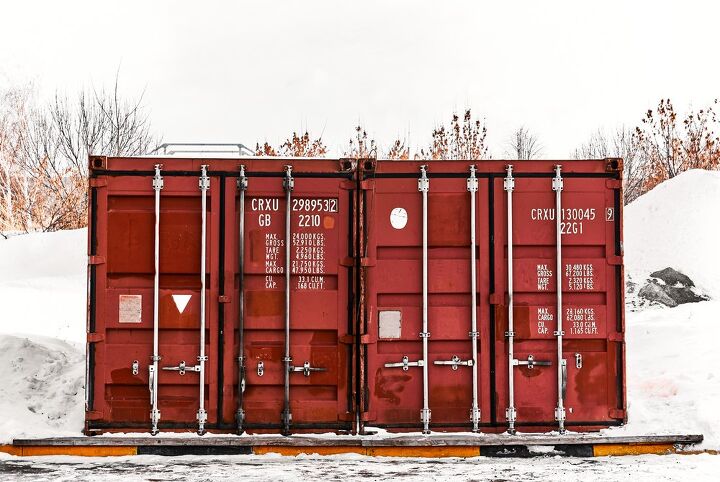Do I Need A Permit To Put A Shipping Container On My Property?

Regardless of size, one common dilemma many households face is the lack of storage space in their homes. Some solutions are renting a remote storage unit, donating items to cut clutter, or placing a shed or container in the backyard. But before you do the latter, find out if you need a permit to put a shipping container on your property.
You usually will not need a permit to put a shipping container on your property. However, the container is considered a temporary structure and must not be present too long to become a permanent fixture. However, if you plan to use the container as a residence or a garden fixture, you most likely will require a permit.
There are a few specific instances when a permit is necessary to put a shipping container on your property. The need all depends on your locality’s codes, ordinances, and regulations. Always do your research for the specific city, county, and state you are in, as rules vary widely.
Do You Need a Permit Service?
Get free, zero-commitment quotes from pro contractors near you.

When Do You Need A Permit To Put A Shipping Container On Your Property?
Not all situations require you to get a permit for putting a shipping container on your property. But, it is ultimately your responsibility to know when you need one and when you don’t.
Do You Need A Permit To Put A Shipping Container On Your Property For Storage?
When there isn’t enough space, some homeowners decide to place a shipping container on their property for storage. Containers are popular storage units as they are airtight and made of sturdy metal. Shipping containers 10-feet long are the perfect size for backyard storage.
Shipping containers for storage may still require some type of permit from your local building officials. These may be relatively easier to obtain if you guarantee that the container does not become permanent. The size of the container is important to note and may affect the authority’s decision to grant you a permit.
Do You Need A Permit To Put A Shipping Container On Your Property For A Garden Shed?
Turning a shipping container into a garden shed allows you to grow plants indoors and throughout the four seasons. Most city ordinances will permit you to turn your container into a garden fixture under certain conditions. One such condition is that you situate the container out of sight from neighbors who may disagree with your decision.
A shipping container, after all, is still an industrial-type structure and may not abide by your residential area’s overall aesthetic. Your property may need to have a dividing feature such as a fence or tall hedges to discourage prying eyes. Additionally, your container must remain invisible from adjacent streets in the neighborhood.
Do You Need A Permit To Put A Shipping Container On Your Property For Living Space?
The shipping container is a popular component for adding a wing or building an entire home from several containers. Again, do your due diligence and research your area’s codes and ordinances. A homeowners’ association may also come in between you and your shipping container.
Homeowners’ associations are notorious for ensuring that the overall look of the residential neighborhood holds up to their specific standards. A shipping container as a permanent addition to your home may not go over well with the HOA. Then again, this is all subjective to your specific area and the people living in it.
Before bringing a container home to add to your existing structure, ensure your design plan is in place. This move will help your cause when dealing with the HOA and other building authorities. Not having a plan would make it easier for them to shoot down your idea before you even discuss it.
What Makes A Good Quality Shipping Container?
It is pretty amazing to realize that you can purchase shipping containers almost anywhere these days. New or second-hand, there are slews of sellers ready to do business with you. Checking with the Better Business Bureau (BBB) for reputable dealers may be your best bet.
Not all shipping containers are alike, even when you are looking at the same brand, size, and age. Many of these containers held hazardous materials before finding their way to second-hand container stores or sites. Therefore, here are a few key qualities to look for when purchasing a good, used shipping container.
Check The Shipping Container’s Exterior
When faced with your container of choice, start your inspection by walking around the outside. Check its overall condition, assessing paint and seals all around the edges. You may encounter dents on these containers but ensure that these are superficial.
Check the corners for notable areas of corrosion. When visible, these may mean that the container is not in good condition. However, keep in mind what you need your container for. Structural and aesthetic blemishes are subjective, depending on your specific need for the container.
Examine The Shipping Container’s Interior
Check the doors for proper sealing and ensure that all gaskets, fittings, and locking mechanisms work. Once the doors are open, smell the air for obvious mold or rust. You may encounter a musty smell that could be possible signs of leaking.
Once inside, close the doors to check if the container is airtight. The easiest way to do this is to do your inspection during the day.
The container should be pitch-dark inside, aside from light streaming through the door seal. If you see light coming through other areas, these indicate holes in the structure and may be a problem.
Finally, throw the doors open and do a further walk-through of the interior. Pay attention to floors and check for holes. Always ask the seller the types of cargo that the container carried before being put on the market.
Ask About Delivery Fees For The Shipping Container
Do not save money on your container purchase only to overpay for the delivery charge. You would want the majority of your expense to go on the container itself and not the delivery price. Always discuss all delivery details with the seller before you plunk down your payment.
Ask About Guarantees
Remember that not every seller will supply a warranty or even a guarantee. Hence, it is quite essential to scout out the most reputable seller you can find. You do not want to be a victim of a bait-and-switch once the container arrives at your property.
Make Sure Any Pictures Are Of The Actual Unit
Purchasing a shipping container sight unseen may not be the best idea. However, there are instances when you may not have any choice but to make an online purchase this way. Do double the research on both your seller and the container in question before reaching for your e-wallet.
Related Questions
How much is a second-hand shipping container?
A standard-sized 20-foot shipping container would cost you anywhere from $2,000 to $3,000. A brand-new unit would cost about double the price of a used one. It also depends on a container’s age, condition, and how it was refurbished.
Is it better to buy a new or used shipping container?
The answer to this question all depends on the container’s primary use. If you require one for storage or garden purposes, a good second-hand container may very well do the job. If in need of several to build a primary residence, it may be wise to invest in brand new units.
Do You Need a Permit Service?
Get free, zero-commitment quotes from pro contractors near you.

Summing It Up
You are well within your rights to put a container on your property and use it for your specific needs. Be it for storage, a garden, an additional living area, or even an office space. Do your own research well in advance and employ the assistance of trusted experts.

Stacy Randall is a wife, mother, and freelance writer from NOLA that has always had a love for DIY projects, home organization, and making spaces beautiful. Together with her husband, she has been spending the last several years lovingly renovating her grandparent's former home, making it their own and learning a lot about life along the way.
More by Stacy Randall












![Finishing Basement Without Permit [Is It Really Illegal?]](https://cdn-fastly.upgradedhome.com/media/2023/07/31/9070078/finishing-basement-without-permit-is-it-really-illegal.jpg?size=350x220)













![Standard Dining Room Table Dimensions [for 4, 6, 8, 10 and 12 People]](https://cdn-fastly.upgradedhome.com/media/2023/07/31/9074335/standard-dining-room-table-dimensions-for-4-6-8-10-and-12-people.jpg?size=350x220)
